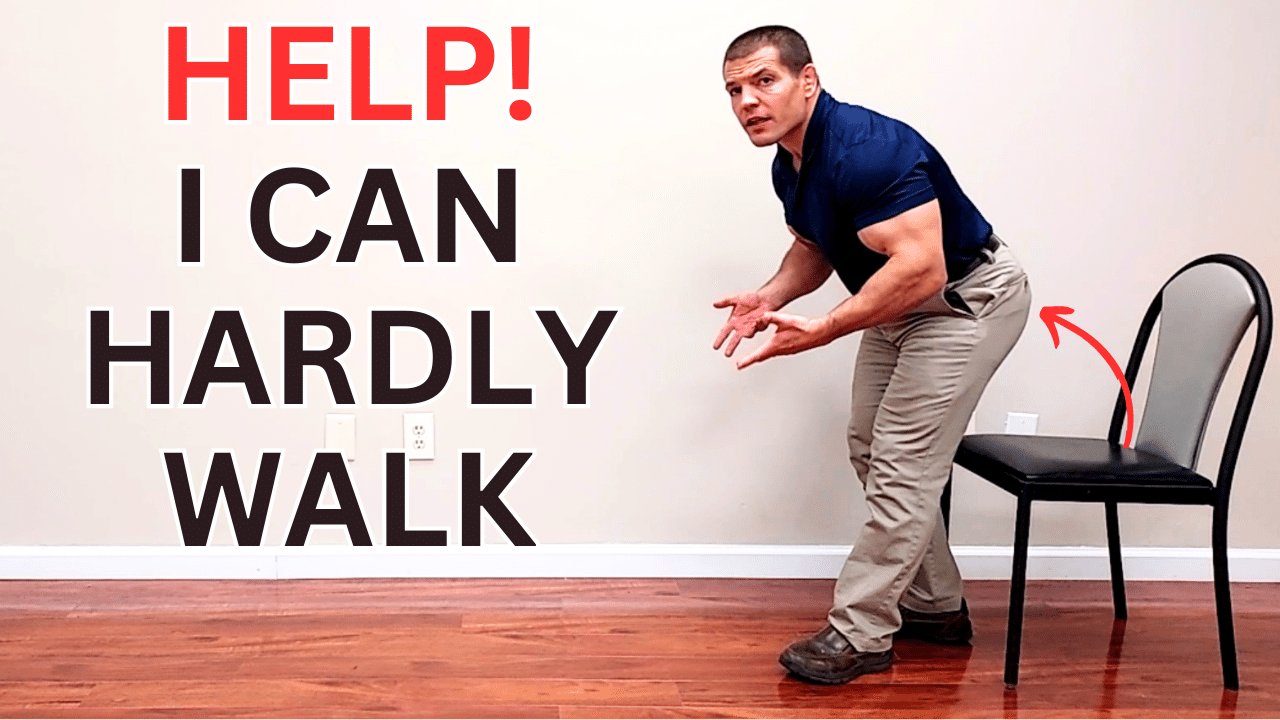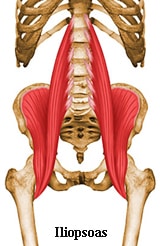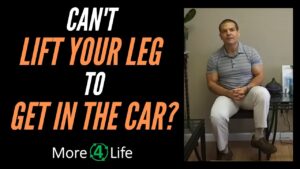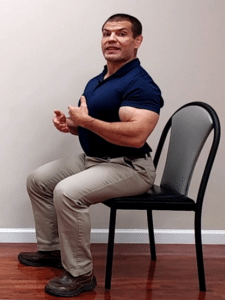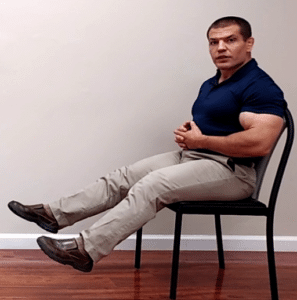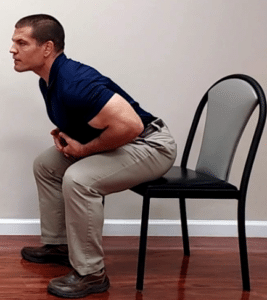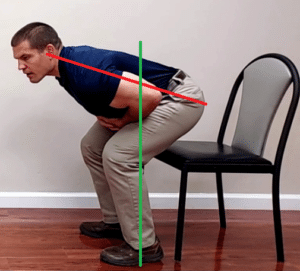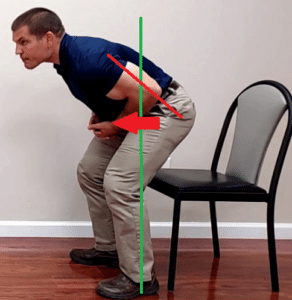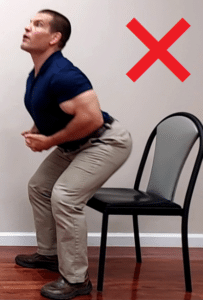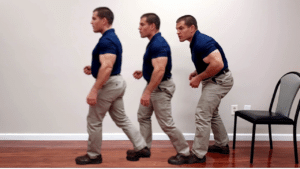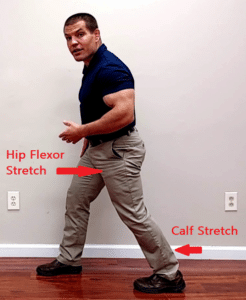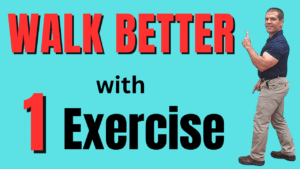If you can hardly walk when you first get up from sitting, or first thing getting out of bed i the morning, then watch this video to make your first few steps in the morning easier and less painful .
What Should I Do If I Can Hardly Walk When I First Get Up?
There are many common situations I encounter where patients can hardly walk when they first get up. Some examples include:
first getting up in the morning
first getting out of the car
eating at a restaurant and then having trouble getting back up
Often times patients feel like they have to walk hunched over for the first couple steps.
In this post, you'll learn an easy method to make it easier to walk when you first get up.
Why Can I Hardly Walk When I First Get Up?
Before we can go over what causes pain when you first get up and how to relieve pain when you start walking after standing up, first we have to figure out what's causing it.
Largely, that stiffness in two muscle groups:
- your hip flexors
- your calf muscles
I've got another post that helps explain some sleeping positions that will help keep you from getting so stiff and painful when you're sleeping at night.
However, in this post I want to go over sitting positions that will make it easier for you to walk when you stand up.
How To Sit To Prevent Pain When Getting Up To Walk
Your hip flexor muscles (iliopsoas) run from your trunk down to your legs.
Most people think of hip flexors as muscles that lift your leg or flex your hip like this:
However, your hip flexors can also work in a reverse action as a postural muscle.
When you're sitting, particularly if you're trying to sit up tall with "good posture" (and more so when sitting without back support), your hip flexors, hold your spine in an arched position.
Your hip flexors help keep you from falling too far backwards.
At the same time, your trunk extensors help keep you from falling too far forwards.
So, you're co-contracting your hip flexor muscles and trunk extensor muscles in order to keep you in an upright position while you're seated.
If you're constantly using those muscles in a shortened position, then when you go to stand back up, those muscles have trouble lengthening back out to allow you to stand up straight.
And that's why you may feel like you have to kind of walk bent over for those first couple steps.
How To Sit To Make It Easier To Walk When You Get Up
One easy way to get your hip muscles to relax when you're sitting, so they're not under quite so much tension the entire time that you're sitting, is to make sure you're sitting all the way back against the backrest.
Your hip flexors are still in a shortened position, but if you can allow yourself to fully relax into the backrest then you're not using them as postural muscles.
Stiff Calves When You Get Up To Walk?
The next thing to look at is your calf muscles. If you're driving in a car with one foot on the gas, you're pointing (plantar flexing) your toes. Additionally, the other foot is usually out trying to support you, and so your toes are in a pointed position on that foot as well.
This puts your calf muscles in a shortened position.
Likewise, if you're sitting in your chair and you have your feet out in front of you, that also puts your calves in a shortened position.
The best case scenario is to have your legs bent to where your knees are at 90 degrees so that your feet are flat on the floor.
Even with optimal posture though, when you sit stationary for long periods of time, your hip flexors and your calves will naturally stiffen up a little bit.
But they're going to stiffen up even more if you sit with them in a shortened position where they're under tension.
How To Stand Up After Sitting A Long Time
When you go to stand up from sitting, a lot of people notice that they either have trouble standing up straight after sitting.
Or, they notice that they can get up, but then when they start to walk, they have difficulty taking that first step.
They feel like they kind of have to walk bent over or hunched over for the first few steps.
So to stand up from sitting without your back bothering you, first scoot to the front of the chair.
Next, pull your feet close to the chair so that they're closer to being under your center of gravity.
Then you want to hinge forward from your hips, keeping a straight spine.
Don't allow your lower back to round.
By doing this, you can get your center of gravity over your feet and stand up with fairly minimal muscle effort.
This is really just gravity and leverage working.
Your weight starts to go over your feet with almost zero muscle effort. Now, there's the fear that you're going to fall forwards, but that's almost physically impossible.
The bulk of your center of gravity (your trunk and buttocks) is behind you, so you're more likely to fall back into the chair than you are to fall forwards.
So this is a safe and effective method to stand up from sitting that requires fairly little muscle effort.
Getting all the way up to standing
Once you get your weight over top of your feet, then you just push your hips underneath you.
This is the sticking point where many people have trouble when they get up to walk.
Then either stand up like this, which jams the joints together in your lower back.
Or, they'll do the standing correctly, get their hips underneath them, and then come all the way up straight, in which case, they're still jamming their lower back joints together.
Because your hip flexors have been in a shortened position while you're sitting, as you go to stand up all the way, your lower back starts to arch.
That's why people feel like they need to walk bent over for the first few steps... because their hip flexors haven't quite stretched out yet.
How Walk When You First Get Up Without Pain
In order to keep your back from bothering you when you first stand up, do the hip-hinging motion, but only come up about 75% of the way
Don't come all the way up to standing yet.
Take a small step and roll your pelvis underneath you.
Then take another small step, and roll your pelvis underneath you.
So you're going to be slightly bent over for the first two or three steps.
During this time, you're actually doing an active hip flexor stretch, in order to allow you to stand up and walk comfortably
Now, what about your calf muscles?
Like I mentioned, your calf muscles also get stiff when you're sitting for a long period of time.
Your calf muscles will also get stiff laying in bed with your toes pointed which can cause foot pain when you first get up in the morning.
When you're taking your first small steps though, you're also kind of stretching your calf muscles with each short step.
If your calf muscles are too stiff when you first get up, it can cause you to overpronate, or flatten your feet, as you start to walk.
However, by taking smaller steps those first couple steps, it prevents you from having to overpronating to take a large step.
Review Of What To Do If You Can Hardly Walk When You First Get Up
To review, when you're sitting down in a chair, you first want to make sure that you sit all the way back in the chair with your back relaxed against the backrest, knees bent 90 degrees, and feet flat on the floor.
Second, when you go to get up, scoot to the front of the chair and bring your feet underneath you. Hinge forward to get your body weight over your feet. Then stand only 75% of the way up.
Finally, take a small step while still slightly bent over to stretch your calf and hip flexor muscles. Repeat this for 2-3 steps and gradually straighten up over those first few steps.
This can help you to walk more comfortably when you first get up without back pain, hip pain, knee pain, or foot pain.
Long Term Strategies To Make It Easier To Walk When You First Get Up
Ultimately, long term, you do want to get your hip flexor muscles and calf stretched out so that they don't get quite so stiff when you're are sitting down or when you're sleeping at night.
Here's one unique exercise to help you stretch your calf and hip flexors while also improving your strength and balance so that you can walk better.
If you live in the St. Louis area and need more help to walk without pain when you first get up, we'd be happy to help you here at More 4 Life.
Just tap the button below to request an appointment with one of our specialist physical therapists.
Additionally, here are some other posts about how to relieve pain when walking:
Why Do I Get Back Pain When I Wake Up?
How To Relieve Pain In Foot In The Morning
Why Does My Ankle Hurt When I Wake Up?
Try This Unique Exercise For Walking Balance, Flexibility, and Strength
Spinal Stenosis And Walking Problems
3 Ways To Relieve Back Pain When Walking

